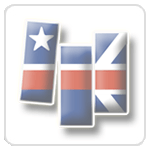
|
MULTIMEDIA-ENGLISH |

|
| ACTIVITY SHEET (created by the user: Profe) |

|
MULTIMEDIA-ENGLISH |

|
| ACTIVITY SHEET (created by the user: Profe) |
Before doing this activity you may need to read the text you will find at the end
|
|
||||||||||||
| Item | Match | Comments |
|---|---|---|
| Me gustan esos zapatos. Los de ahí arriba. | I like those shoes. The ones up there. | |
| Me gustan tus pastelitos. ¿Puedo coger otro? | I like your cakes. Can I take another one? | |
| La bajita es Mary, y la del pelo largo is Shelly | The short one is Mary, and the one with long hair is Shelly | |
| Mi hermano es el más alto de la familia | My brother is the tallest in the family |
también se podría decir THE TALLEST ONE, pero no hace falta |
| ¿Qué pastelitos quieres? - Unos con nata, por favor | What cakes do you want? - Ones with cream, please | |
| Los pimientos italianos son mejores que los franceses | Italian peppers are better than French ones | |
| Llévate el que prefieras | Take the one you prefer | |
| No me gusta ese sofá. Creo que el grande es más cómodo. | I don't like that sofa. I think the big one is more comfortable. | |
| ¿Qué hombre? ¿El de la camisa azul? | Which man? The one in the blue shirt? | |
| Tengo unas velas aquí ¿Quieres una? | I have some candles here. Do you want one? | |
| No tengo coche porque no lo necesito. | I haven't got a car because I don't need one. | |
| Toma estos libros, son los que necesitas en este momento | Take these books, they are the ones you need at this moment | |
| Este teléfono no es el mío | This phone is not mine | |
| ¿Ves ese chico, el que está sentado allí? Es mi primo | See that boy? The one sitting there? That's my cousin | |
| Una oficina de correos? Sí, hay una cerca de aquí. | A post office? Yes, there's one near here |
 We use ONE instead of repeating a noun. We use ONE for singular nouns, and ONES for plurals.
We use ONE instead of repeating a noun. We use ONE for singular nouns, and ONES for plurals.
- What beautiful flowers! Can I have one? (one=flower)
- Who is your girlfriend? - The one in the red shirt
- I'd like a hamburger. One with lots of onion, please.
- Would you like to try these shoes, sir? - No, the black ones, please.
- Natural flowers are much better than artificial ones.
- Look at those children. The ones playing football. They're from San Francisco.
 We don't use ONE for uncountable nouns, we use SOME or nothing it goes with an adjective
We don't use ONE for uncountable nouns, we use SOME or nothing it goes with an adjective
- If you like mangos, I can give you one.
- If you like brown sugar, I can give you some.
- If you don't like French wine, we can buy Spanish (not: Spanish one)
 Some grammatical words, etc can be used with a noun or alone, so they don't need to use ONE
Some grammatical words, etc can be used with a noun or alone, so they don't need to use ONE
- Which do you like? (also: which one)
- He is the tallest (also: he is the tallest one)
- That's your book and this is mine (not: my one)
- Banana or apple? - I'll take both (not: both ones)
- I need more dollars, I have few (not: few ones)
 NOTE FOR SPANISH SPEAKERS
NOTE FOR SPANISH SPEAKERS
En español, cuando queremos evitar repetir el sustantivo, en la mayoría de los casos simplemente lo suprimimos y ya está, así que hay que tener cuidado porque en inglés casi nunca se puede suprimir.
1 - Which is your boy? - The one in the blue coat (one=boy) = ¿cuál es tu niño? - el del abrigo azul
2 - I want a cake. A big one with lots of cream (one= cake) = quiero una tarta. Una grande con mucha nata
En el ejemplo 1 el español sustantiva el artículo EL y en el ejemplo 2 sustantivamos el adjetivo GRANDE. En inglés ni los artículos ni los adjetivos pueden sustantivarse, tienen que ir siempre acompañando a un nombre; por eso si no queremos repetir el nombre usamos ONE, plural: ONES.
- I like those shoes. The ones near the window = me gustan esos zapatos. Los de al lado del escaparate
- Green apples often taste better than red ones = las manzanas verdes suelen saber mejor que las rojas